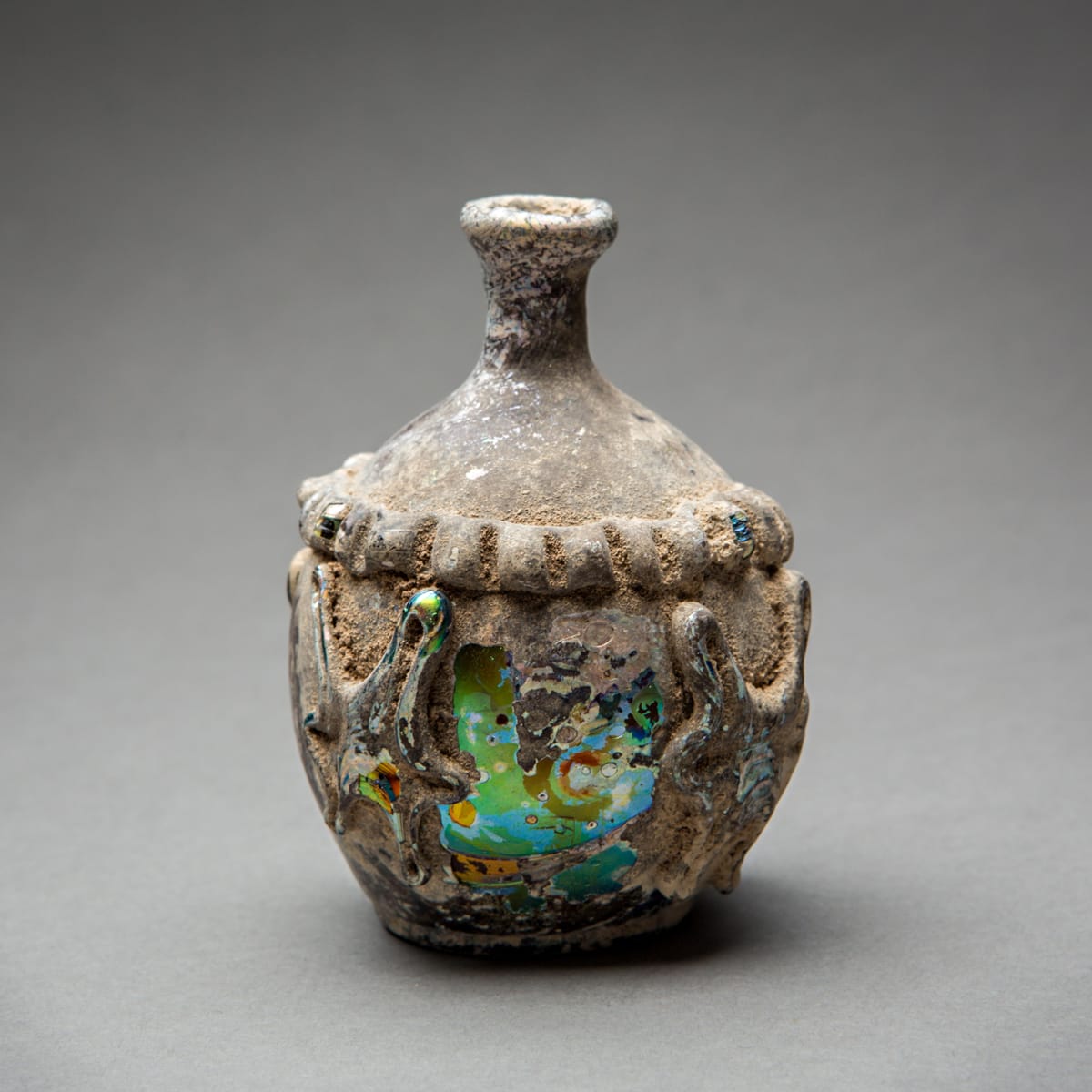Early Islamic Aubergine Glass Bottle, 600 CE - 900 CE
Glass
7.9 x 5.8 cm
3 1/8 x 2 1/4 in
3 1/8 x 2 1/4 in
G.0336
Further images
Early Islamic glass is often indistinguishable from late Classical/Byzantine and Sassanian models. The advent of Islam and the creation of a vast political empire did not have an immediate impact...
Early Islamic glass is often indistinguishable from late Classical/Byzantine and Sassanian models. The advent of Islam and the creation of a vast political empire did not have an immediate impact on the practices of glass-making workshops that had existed for centuries, especially in the Eastern Mediterranean coastal regions. By the seventh century most of the techniques used to work glass by hand had been perfected. The major breakthrough occurred in the first century BC with the invention of glass-blowing. Rather than casting vessels in molds which was an expensive and time-consuming process, the blow-pipe increased the speed and efficiency of production. However, during the early centuries of Islam, glass-makers used this ancient technology in new ways to produce distinctively Islamic wares. They excelled in the application of decoration to blown wares and this small globular bottle is a perfect example of this trend.
The decoration of this vessel was carried out whilst the glass was still hot and thus in a malleable state. Trails of molten glass were delicately applied to the surface of the body and manipulated to form a band of six-pointer star motifs. A thick thread encircles the upper part of the body and has been shaped with a pointer tool or pincer to create a rib-like effect. The spherical body is slightly irregular in shape and terminates in a narrow, flaring neck. Other bottles of this type have slightly wider necks. It is believed that the narrower ones were used as perfume sprinklers or to hold other expensive liquids that needed to be dispensed in small amounts. The production of glass vessels with this style of applied decoration seems to have been concentrated in the Syrian region. Over the centuries the surface has acquired an opaque, pearly-white patina but there are also areas in which the deep aubergine hue of the glass is clearly visible. (AM) Small bottle, free-blown brownish glass with trailed decoration. The globular body has tall sloping shoulder, short neck and terminates in a bulge and rests on an applied ring with deeply sunken concave base. The body is decorated with four roughly H-shaped trailed designs and a horizontal ribbed band around the base of the shoulder.
Syria or Palestine, 7th – 8th century.
Ht. 8cm; Top diam. 1.5cm; Base diam. 3.5cm. Comparative material: Carboni, cat.no.5a, inv.no. LNS 39 KG, pp.26-27, cat.no.1.4b, inv.no. LNS 63 KG, pp.38-39; Israeli, cat.nos.434-435, p.335.
Prof. Geza Fehervar Prof. Geoffrey Kin
The decoration of this vessel was carried out whilst the glass was still hot and thus in a malleable state. Trails of molten glass were delicately applied to the surface of the body and manipulated to form a band of six-pointer star motifs. A thick thread encircles the upper part of the body and has been shaped with a pointer tool or pincer to create a rib-like effect. The spherical body is slightly irregular in shape and terminates in a narrow, flaring neck. Other bottles of this type have slightly wider necks. It is believed that the narrower ones were used as perfume sprinklers or to hold other expensive liquids that needed to be dispensed in small amounts. The production of glass vessels with this style of applied decoration seems to have been concentrated in the Syrian region. Over the centuries the surface has acquired an opaque, pearly-white patina but there are also areas in which the deep aubergine hue of the glass is clearly visible. (AM) Small bottle, free-blown brownish glass with trailed decoration. The globular body has tall sloping shoulder, short neck and terminates in a bulge and rests on an applied ring with deeply sunken concave base. The body is decorated with four roughly H-shaped trailed designs and a horizontal ribbed band around the base of the shoulder.
Syria or Palestine, 7th – 8th century.
Ht. 8cm; Top diam. 1.5cm; Base diam. 3.5cm. Comparative material: Carboni, cat.no.5a, inv.no. LNS 39 KG, pp.26-27, cat.no.1.4b, inv.no. LNS 63 KG, pp.38-39; Israeli, cat.nos.434-435, p.335.
Prof. Geza Fehervar Prof. Geoffrey Kin
Literature
V1





